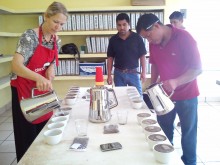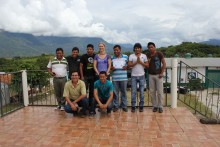
It is exciting to think about how much has changed in the last decade in the specialty coffee sector. Today the idea of training staff and farmers to learn how to taste coffee is common practice, and the coffee industry recognizes the inherent need to have trained personnel knowing their coffee. The improvements have been vast, however, the simple goal of direct and open communication to create a common coffee language around coffee remains a core goal for Cooperation in Quality. What does coffee quality really mean?
Truth be told, you can’t talk about coffee quality in a vacuum. Each piece is related; in the coffee laboratory, for example, we have to look at everything from the color of the green coffee, to proper roasting techniques, to tasting methodology, through to the finished product. Each step affects the next step. Coffee is an apprenticeship and one poorly prepared sample could mean the difference between acceptance or rejection by the cupper - which ultimately affects the farmer, the co-op and the money they earn.
This is one of the key reasons Cooperation in Quality was created, to professionally develop and empower the small farmer supply chain through quality. When coffee cuppers have a deep understanding of what our needs are as buyers–what it means to deliver top notch coffee to Equal Exchange–this strengthens the small farmer supply chain. One of the most effective ways to find quality coffee is to empower the people that live and breathe it.
A Taste of What We Do (Pun Intended)
We had a fun and diverse group of cuppers this year; some with more than 16 years of coffee experience and others with less than 2 years. Together, we embarked on a three-day sensory extravaganza: tasting coffees from all over the world, learning the art and science of roasting, and sharing our respective experiences. That all started - where else - but on the cupping table.
Cupping

Step one: get the group preparing and cupping immediately. This means measuring out and grinding coffee, preparing the water and starting the process to taste the coffee together. Cupping is a very intimate and process-heavy experience. I am extremely particular about the preparation: quality control and consistency go hand-in-hand. We don’t just smell and taste the coffee; our work is full of details that have to be carefully executed, which requires time and practice. Each cupping lasts less than one hour and is followed by a long group discussion about what each person smelled and tasted on the table.
Having the space to intimately describe your individual experience can be both intimidating and empowering. You describe your opinion of a particular coffee and later you get to hear how other people describe the same coffee. It is a powerful way to learn from others. It is an exercise in calibration; we learn about each person’s experience - their perception of acidity, the weight and texture of the coffee, and the different flavors they find in it - maybe tangerine, hazelnut, or dark chocolate. I like to create an atmosphere of sharing and respect. Everyone is born with a different set of taste buds and providing an open space is vital for a cupper to find their voice. It is a space for healthy disagreement and ultimately a place to learn.
A key element of Cooperation in Quality is sensory skill building, and not just on the cupping table, but in all aspects of coffee quality and in life.
Roasting

I could feel the rush of excitement and nerves as each participant took a turn stepping up to the two barrel roaster to begin their first roast with a new and unfamiliar system. Working in pairs, one person as the roaster and the other serving as notetaker, immediately I saw them take on a sense of ownership over the roast, calling out to one another the time, color and smell of the roasting coffee, using their senses:
“Four minutes, yellow/brown, 150, smells like bread - no, cereal!”
They were excited, loud and laughing, but at the same time, serious. They were having fun and I was filled with a sense of pride as they worked through the process to roast each sample. They did a fantastic job working in teams, communicating to one another, and recording the information to later critique their roasts on the cupping table.
Sweet & Sour

As I talked about the characteristics of citric acid, which gives coffee a bright and zesty flavor that is lemon-like in flavor, and is formed during cellular respiration through the process of photosynthesis, one of the cuppers, Calixto Guillen Vazquez from Finca Triunfo Verde co-op looked at me and said, “Roya [coffee leaf rust] causes the leaves to fall off.”
Calixto’s comment gave me pause. We looked at each other sadly, knowing that this could very well mean that the wonderful, delicious citric acid that could be forming during cellular respiration, would not because of Roya, the coffee fungus which has been spreading throughout Chiapas. Roya has devastated farms all over Latin America and this year the coming harvest could be down by as much as 50 percent for some farmers in Chiapas.
From an economic standpoint, this will dramatically affect the lives of the coffee farmers. And although steps are being taken by the co-ops to try to rescue trees and slow Roya down, there are so many unknowns. The role of climate change and the need for more organic fertilizers both play a significant role in the future of coffee. As we tasted infused coffee during our tasting exercise, which I had spiked with citric acid as an example, I thought about what this could mean and how this one exercise displayed a looming fear that came to light in a way I had not quite imagined. It was a learning moment for me that was powerful, and once again, highlighted the reason we do this seminar. Cooperation in Quality is about connecting people, cooperating among cooperatives, and sharing information. It is a never-ending process of learning for everyone.
Each Cooperation in Quality seminar is different, and over the years I have worked with more than 40 coffee quality personnel from co-ops all over the world. Sharing knowledge is an important aspect of what we do at Equal Exchange and building capacity in coffee quality contributes to a stronger small farmer supply chain. Knowledge is empowerment.
Would you like to try some fantastic coffee from Mexico? Check out:
- Organic Bird of Paradise - Medium Roast (seasonal offering)
- Organic Mind, Body & Soul - Medium & Vienna Roasts
